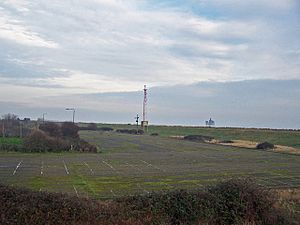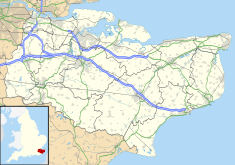Kent Refinery facts for kids

Former site in December 2007
|
|
| Country | UK |
|---|---|
| City | Isle of Grain |
| Coordinates | 51°27′00″N 0°41′20″E / 51.45°N 0.689°E |
| Refinery details | |
| Operator | BP |
| Owner(s) | Anglo-Iranian Oil Company, BP |
| Commissioned | 1953 |
| Decommissioned | 1982 |
| Capacity | 11 million tonnes per year |
| No. of employees | 1,500 |
The BP Refinery (Kent) was a large oil refinery located on the Isle of Grain in Kent, England. It started working in 1953 and could process up to 11 million tonnes of crude oil each year. The refinery stopped operating in August 1982.
Contents
History of the Kent Oil Refinery
Early Oil Industry in the Area
The oil industry began on the Isle of Grain in 1908. The British Navy built a place there to store oil and refuel ships. Later, in 1923, another company called Medway Oil and Storage Company (MOSCO) built an oil refinery nearby. MOSCO was later bought by the Anglo-Persian Oil Company (APOC) in 1932, which later became BP. After this, the oil refining at Grain stopped for a while.
During World War II, a special pipeline was built to the Isle of Grain. This pipeline was part of a secret project called DUMBO, which helped supply fuel for Operation Pluto.
After the war, the UK government wanted to build more oil refineries. This was to save money by refining oil from the Middle East in the UK. The BP Refinery (Kent) was one of these new refineries. It was built in a rural area, which changed the landscape but also created many jobs.
Building the Refinery
The Anglo-Iranian Oil Company started building the Kent Refinery in 1950. It was also sometimes called Grain Refinery. Building this huge site needed a lot of work.
Workers had to fill in several water channels on the land. They used a million cubic yards of soil to do this. They also raised the ground level in some areas with compacted sand from the sea.
About 6,000 concrete piles were used to create strong foundations for the heavy machinery on the marshy ground.
A bay on the River Medway was closed off to create a reservoir for cooling water. A long water channel was built to carry this water to the refinery's pump-house. The refinery's cooling system could circulate 3.5 million gallons of water every hour!
Initially, five new jetties (docks) were built on the River Medway. These jetties were large enough for ships carrying up to 32,000 tonnes of oil. A deep channel was also dug in the river to allow these big ships to reach the jetties from the Thames Estuary.
The first part of the construction used:
- 37,000 tonnes of concrete
- 119,000 tonnes of steel
- 14 million bricks
- 600 miles (965 km) of pipes
At its busiest, 8,000 workers were on the site. About 1,500 of them lived in a special camp built just for them.
In 1952, a pipeline that went from the Thames to Grain was reused. It now carried refined fuel from the Kent refinery to a storage depot. This meant new pumps had to be installed.
The first phase of building the refinery cost about £40 million.
How the Refinery Produced Oil Products
The first tanker carrying 27,000 tonnes of crude oil arrived at the refinery in October 1952.
The refinery started working in different stages:
- Stage 1 began in February 1953. This included the main unit for separating crude oil.
- Stage 2 started in October 1953. This added a unit for "catalytic cracking," which breaks down heavy oils into lighter, more useful products like petrol.
- Stage 3 was ready in Summer 1954. This part made lubricating oils.
- Stage 4 opened in Spring 1955. This added another unit to improve the quality of petrol.
In January 1953, the refinery site was flooded by the East Coast floods. The site was covered in water and mud, and some pipes were moved. But the refinery still managed to start working just three weeks later!
The refinery could initially process four million tonnes of crude oil each year. Most of this oil came from the Middle East, with smaller amounts from other places like Libya and South America.
On April 5, 1955, Queen Elizabeth II and the Duke of Edinburgh visited the refinery.
Over the years, the refinery's capacity grew, and new processes were added. By 1971, it could process 11 million tonnes of oil per year. From June 1975, the refinery also started processing crude oil from the North Sea in Britain.
The refinery provided many jobs for local people. Before it was built, many people in the area worked on farms for very low wages.
What the Refinery Made
The Kent Refinery produced many different products from crude oil. These included:
- Liquefied butane (used for heating and cooking)
- Motor spirit (petrol for cars)
- Aviation spirit (fuel for planes)
- Aviation kerosene (jet fuel)
- Burning oil (paraffin for lamps and heaters)
- Gas oil (diesel fuel)
- Fuel oil (for power stations and industrial use)
- Lubricating oils (for engines and machinery)
To make these products, the refinery had many complex units. These units would separate the crude oil into different parts and then treat them to make the final products. For example, "crude distillation units" would heat the oil to separate it into different liquids and gases. Other units like "catalytic crackers" would break down heavier parts of the oil into lighter, more valuable ones. There were also units to remove impurities like sulphur.
By 1961, the refinery had cost £88 million to build.
Closure of the Refinery
In the 1970s, the price of oil went up a lot. This meant people used less oil, and there was too much refining capacity in Europe. Because of this, BP Oil announced in August 1981 that the Kent refinery would close in 1982. This meant 1,670 workers would lose their jobs, plus another 1,000 construction jobs in the area.
The Kent refinery officially closed on August 27, 1982. The oil storage part of the site continued to operate for some years. The last time oil was moved by train from Grain was in 1999.
After the refinery closed, parts of the site were used for other purposes. British Gas developed some of the western part into a liquefied natural gas plant called Grain LNG Terminal. Another part became the London Thamesport container terminal.
Structure of the Refinery
At its largest, the refinery and its oil storage tanks covered an area of four square kilometres (400 hectares).
The main parts of the site included:
- A large office building for administration.
- 22 miles (35 km) of roads within the refinery and tank farm.
- Four rail sidings where refined oil products were loaded onto trains.
- Nine large jetties for oil tankers and three smaller ones.
- The main crude oil separation column was 140 feet (43 m) high.
- Liquefied Petroleum Gases (LPG) were stored in special round tanks called Horton spheres.
- Crude oil tanks were in the north-east part of the site.
- Fuel oil and other product tanks were in the south.
- Some petrol tanks were even stored underground in the north-east.
The oil-fired Grain Power Station was built next to the refinery in the late 1970s. It used fuel oil from the refinery to make electricity.
The refinery could be reached by road using the A228 and B2001 roads.
Images for kids
See also
- Historic England Archive
- Fawley Refinery
- British Petroleum



